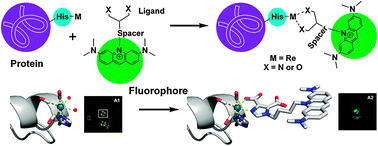Post-protein binding metal-mediated coupling of an acridine orange-based fluorophore†
Abstract
The HEW lysozyme (Lys) and the fac-[Re(CO)3(H2O)3]+ complex (1) are used as a simple model system for the description of a new approach to the labelling

Maintenance work is planned for Wednesday 1st May 2024 from 9:00am to 11:00am (BST).
During this time, the performance of our website may be affected - searches may run slowly and some pages may be temporarily unavailable. If this happens, please try refreshing your web browser or try waiting two to three minutes before trying again.
We apologise for any inconvenience this might cause and thank you for your patience.
* Corresponding authors
a
Institute of Inorganic Chemistry, University of Zürich, Winterthurerstrasse 190, CH-8057 Zürich, Switzerland
E-mail:
fzobi@aci.uzh.ch
Fax: +41 044 635 6802
Tel: +41 044 635 4623
The HEW lysozyme (Lys) and the fac-[Re(CO)3(H2O)3]+ complex (1) are used as a simple model system for the description of a new approach to the labelling

 Please wait while we load your content...
Something went wrong. Try again?
Please wait while we load your content...
Something went wrong. Try again?
 Fetching data from CrossRef.
Fetching data from CrossRef.
This may take some time to load.
Loading related content
